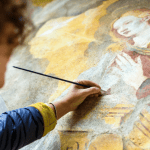 Animals
Animals  Animals
Animals  History
History 10 Most Influential Protests in Modern History
 Creepy
Creepy 10 More Representations of Death from Myth, Legend, and Folktale
 Technology
Technology 10 Scientific Breakthroughs of 2025 That’ll Change Everything
 Our World
Our World 10 Ways Icelandic Culture Makes Other Countries Look Boring
 Misconceptions
Misconceptions 10 Common Misconceptions About the Victorian Era
 Mysteries
Mysteries 10 Strange Unexplained Mysteries of 2025
 Miscellaneous
Miscellaneous 10 of History’s Most Bell-Ringing Finishing Moves
 History
History 10 Great Escapes That Ended Right Back in Captivity
 Weird Stuff
Weird Stuff 10 Fascinating Things You Might Not Know About Spiders
 Animals
Animals 10 Animals That Humiliated and Harmed Historical Leaders
 History
History 10 Most Influential Protests in Modern History
 Creepy
Creepy 10 More Representations of Death from Myth, Legend, and Folktale
Who's Behind Listverse?

Jamie Frater
Head Editor
Jamie founded Listverse due to an insatiable desire to share fascinating, obscure, and bizarre facts. He has been a guest speaker on numerous national radio and television stations and is a five time published author.
More About Us Technology
Technology 10 Scientific Breakthroughs of 2025 That’ll Change Everything
 Our World
Our World 10 Ways Icelandic Culture Makes Other Countries Look Boring
 Misconceptions
Misconceptions 10 Common Misconceptions About the Victorian Era
 Mysteries
Mysteries 10 Strange Unexplained Mysteries of 2025
 Miscellaneous
Miscellaneous 10 of History’s Most Bell-Ringing Finishing Moves
 History
History 10 Great Escapes That Ended Right Back in Captivity
 Weird Stuff
Weird Stuff 10 Fascinating Things You Might Not Know About Spiders
10 Misconceptions in Art & Architectural History
Art history is filled with captivating stories, iconic masterpieces, and legendary artists—but not everything you’ve heard is true. From misattributed paintings to misunderstood movements, the art world has its fair share of myths and mix-ups. In this list, we’re setting the record straight by debunking some of the most common misconceptions in art and architecture.
Related: 10 Common Misconceptions About the Origins of Beloved Things
10 The Pyramids Were Built by Slaves
The Pyramids of Giza are the only one of the Seven Wonders of the World still standing, making it one of the most significant pieces of art and architecture in all of history. It’s almost impossible to look at these massive structures and not wonder how humans could have built them without any modern technology.
Most people think that they were built by slaves, but that’s not true. While some other pyramids and large buildings throughout Ancient Egypt may have been constructed using unpaid labor, the workers who built the famous Pyramids of Giza received compensation. To be fair, they weren’t paid in the traditional sense. Instead of money, they were given food and supplies.
Excavations from around the pyramids revealed the tombs of some workers. The artifacts contained within these tombs included some valuables and personal items—things that would not have been buried with common slaves. Thus, historians have commonly considered these workers to be skilled laborers rather than slaves.[1]
9 The Mayan Calendar Predicted the End of the World
On December 21, 2012, the world stood still. Millions waited to see if the Mayan Long Count calendar was right, and the world would end in 2012.
It didn’t, obviously. And anyone who did research on the ancient calendar would have known this. The large, circular calendar was created in 3113 BC and was used by the Mayans to keep track of time in cycles.
The 13-baktun cycle ended on December 21, 2012. Many conspiracy theorists believed that the Mayans had some sort of spiritual connection to the future and that they were trying to communicate that the world would end on this date.
In reality, the calendar represents a cycle, so it starts over again. It didn’t mean the world would end, but a new cycle would begin. Though scientists and historians tried to debunk the panic, it wasn’t until the clock safely turned to December 22 that people realized their error.[2]
8 Van Gogh Cut Off His Ear Because He Couldn’t Paint It
As outlandish as it sounds, Vincent Van Gogh actually did cut off his own ear. The myth involved in this historical story is the motive for the self-mutilation.
Many believe that, while painting his famous self-portrait, Van Gogh could not get his left ear drawn just right. In order to avoid this, he simply chopped it off, allowing his painting to be left ear-less.
As dramatic as this story is, it’s not true. Van Gogh cut off a small part of his earlobe after a fight with a friend. He had suffered mental issues such as hallucinations and depression his entire life, and historians generally agree that a manic episode was the reason for his odd behavior.
Oh, he also gave that ear to a prostitute at a local brothel. Hopefully not in lieu of actual payment.[3]
7 Georgia O’Keeffe’s Flowers Represent Female Genitalia
American modernist painter Georgia O’Keeffe is famous for her colorful and magnified depictions of flowers. Part of the reason her work became so popular in the 1970s, despite being created in the 1920s, was thanks to the impending feminist movement.
Women’s rights activists (and many men, including O’Keeffe’s husband) saw the close-ups as images of the female genitalia. They’re still often interpreted as such and used as a statement of female empowerment, since vulvas and vaginas are often seen as… distasteful.
But O’Keefe herself vehemently denied these interpretations, insisting they were simply flowers. While it’s true that art is up to interpretation, many art historians are trying to honor her original intent and recontextualize the art.[4]
6 Salvador Dalí Invented Surrealism
Though he is almost certainly the most famous surrealist artist in history, the eccentric Salvador Dali did not actually invent the art form.
Surrealism is known for its illogical and often dreamlike scenes. The bizarre juxtapositions and interesting imagery have made it one of the most recognizable types of art to come out of the early 20th century.
Most of the most well-known surrealist paintings, such the “The Persistence of Memory” and “The Great Masturbator,” were painted by Spanish surrealist (and incredible mustache-grower) Salvador Dali. His odd demeanor and famous works made him the face of the movement, but contrary to popular belief, the art form was coined in 1917, when Dali was just 13 years old.[5]
5 Picasso Invented Cubism
This one is sort of a half-truth. While Pablo Picasso did significantly help develop the avant-garde art movement known as cubism, he did not do it alone.
French painter Georges Braque collaborated with the famous Spanish multimodal artist. Around 1907, the two worked in Paris on breaking down objects into basic geometric shapes. From these, they created entire collage-like paintings and sculptures that are still popular today.
Both men influenced each other to an indefinable degree. It’s impossible to say which one of them truly invented cubism. So it’s generally agreed upon that they both did.[6]
4 There Was No Art During the Dark Ages
The period of time from the 5th to the 10th centuries is colloquially known as the Dark Ages. Scholars in the Renaissance period coined this term to indicate the fall of the Roman Empire and the decline of literary, artistic, and scientific activity.
The nickname has stuck—maybe a little too well. The so-called Dark Ages were actually a time of great technological and even artistic betterment. Although the art of the time wasn’t as elaborate or popular as that from other eras, there are quite a few examples of important art pieces.
One of the most unique examples of this is illuminated manuscripts, large books that were decorated by monks and other skilled artisans. The Book of Kells and the Lindisfarne Gospels are still visited by admirers from all over the world.[7]
3 American Gothic Features a Married Couple
Even though it seems quite straightforward, this often parodied painting is also frequently misunderstood.
The iconic image of a man with a pitchfork next to a straight-laced woman in front of a rural white house with gothic windows has become the epitome of small-town America. Most people assume that the people in Grant Wood’s American Gothic are a married couple. But that’s wrong.
The farmer was modeled after 62-year-old Dr. Byron McKeeby, a dentist from Iowa, and the woman was based on Wood’s 32-year-old sister. The two never met in life, and within the painting, they are meant to be father and daughter. This pairing gives us a visual metaphor for the generational continuity and old-fashioned family structure inherent in rural American values, rather than the romance and whimsy of marriage.[8]
2 Michelangelo Painted the Sistine Chapel Lying on His Back
Popular myth has it that while painting the ceiling of the huge Sistine Chapel, Michelangelo spent most of the time lying down in order to reach the high, arched areas. This probably stems from the 1965 movie The Agony and the Ecstasy, which portrays the artist (played by Charlton Heston) on his back while painting.
But there’s no real-life evidence to suggest this actually happened. On the contrary, Michelangelo actually designed and built his own scaffolding system that allowed him to stand and paint more comfortably. While the system allowed him to stand up while working, the ceiling was still above him, forcing the artist to paint with his neck curved upward. This caused him immense pain—so much that he famously wrote to a friend that “I’ve grown a goiter from this torture… hunched up here like a cat.”
So while it certainly wasn’t a pleasant experience, he stood for most of the four years it took to complete.[9]
1 Greek and Roman Sculptures Were Always White
In 2022, the Metropolitan Museum of Art dotted its Ancient Greek and Roman statue gallery with a few painted sculptures. The idea was to give modern-day viewers a better idea of what these statutes actually would have looked like thousands of years ago.
That’s right, the white marble men, women, and gods we’re used to seeing in art museums frequently started with a bright coat of paint. They weren’t created in a monochrome. Researcher Vinzenz Brinkmann has been collecting evidence “like a stamp collection” for the last 40 years, ever since he first saw traces of color on ancient statues.
Written sources from the time mention bronze frequently, suggesting that most sculptures and icons at the time may have been made of this material and painted. Unfortunately, because the majority of states that have survived to present day are made of marble, which is more durable and long-lasting than other materials, we’ve come to associate the Greeks and Romans with this colorless type of art.[10]








